Over the long weekend of 22-26 September, Homer, Illinois enjoyed a mini tourist boom as The Gamers, Inc. held its annual Open Gaming Retreat. Turnout was good, with 22 guys taking a break from the routine and flying or driving in for cool, sunny fall days, intermittent rain, country cooking, giant burritos-and wall-to-wall wargaming.
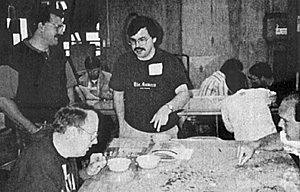 Dave Demko (center) attempting to explain away the catastrophe on the Eastern Front to J. Akens--meanwhile, Bill Quoss (left, seated) is finishing off Dave's army...
Dave Demko (center) attempting to explain away the catastrophe on the Eastern Front to J. Akens--meanwhile, Bill Quoss (left, seated) is finishing off Dave's army...
The Field of Battle
The retreat was, as always, a non-convention. With no big dealers' room, no complex schedule of seminars and presentations, no registration fees, and no contests, tournaments, or ceremonies, the retreat had little to distract participants from playing games and shooting the breeze with old and new friends. Also, the event's organization was simple and effective. The Gamers crew had maps set up under Plexiglas, open gaming tables, and a sign-up sheet keyed to the tables. Incoming players could choose a game, choose their opponents, and dive fight into the action. At the conclusion of one game, players easily found other games of interest, partners interested in playing them, and space to set up.
Most of the gaming went on in The Gamers' big, bright playtest room, with a few tables set up in the warehouse, where we played with a backdrop of Gamers inventory. (By the way, I counted only about 90 copies of Enemy at the Gates boxed and ready to ship. I'm sure--I hope Dean has more yet to be packaged, to keep up with demand.) The environment afforded adequate elbow room, plenty of dice and spare markers, and ample opportunity to share opinions and check out other games in action.
I spent more time playing Enemy at the Gates than playing journalist, so I can't tell everyone's story. I quizzed several guys about how their games were going, how rules were working, and so on. Of course, I heard about several "hot dice" and "bad dice" episodes.
The Play's the Thing
I joined Don Nesbitt to play the Axis in EatG and confront Maurice Buttazoni and Bill Quoss in Scenario 9, the Campaign Game starting from the end of January. The set-up for this one has a tiny force left in the Stalingrad pocket, ready to starve, while the Soviets have chased the rest of the Axis off the easternmost two maps. On paper, things look very bad for the Germans, but we discovered that this scenario feels balanced. Yes, the Axis has to go into rapid retrograde run-away mode to survive the first turn, but as play develops both sides have the room, the supply, and the mobile forces necessary for offensive actions.
In the south, I tried to hold Rostov and Voroshilovgrad and keep from being pocketed by Bill's advance. On Map A, Don gave ground in front of Kharkov and looked for opportuntities to counterattack. I tried an orderly withdrawal at first, maintaining a solid line. Bill, thanking me silently, blitzed and skillfully punched some holes. I saved myself with a dramatic (and ultimately wasteful) counterattack by the 3rd Panzer. Seeing a couple Tank Corps all but evaporate under that counterattack, Bill switched to Soviet-style offensive mode. He used all arms in a compact mass to apply deliberate, relentless pressure against my troops. With plenty of mobile divisions, I was better equipped to attack than to hold a line. So I took some pressure off Rostov with a four-division raid against the forces besieging that city. Hey, I could take a big risk or lose the city for sure. I chose the fun option.
Maurice felt he had Don on the ropes, but he soon became the victim of his own success. We have all read the player's notes about not letting the Soviet mobile formations get too far ahead of their infantry. But maybe you need to experience what can happen before the lesson really sinks in. In a wide-open situation, Don spotted what he thought was a way to cut supply to the whole Soviet front line with a raid to seize a key bridge. He sent a panzer division and just about gave Maurice a heart attack, but with some frantic shuffling of SPs and trucks, Maurice avoided a long and painful set of attrition rolls. Maurice surrounded the pesky panzer division and took his revenge, but there were more where that one came from. Again the Soviets had to react to panzers breaking into their rear areas, with the ultimate result of lost momentum. After 7 or 8 game turns in a day and a half of play, we called it a gentlemen's tie.
Except for the first two turns, when the Axis won the roll-off, the initiative switched every turn. In effect, each side ended up getting back-to-back player turns and therefore the ability to run sustained, high-intensity operations. The result was a wide-open, see-saw fight.
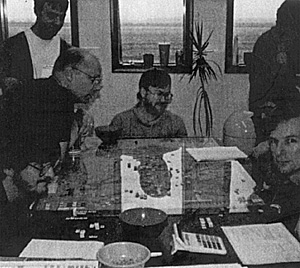 Marathon Tunisia (l-r): Dean Essig, Boyd Schorzman, Dan Bartlett, Dave Powell, Marty
Arnsdarf (facing away), Rod Miller, Dave Friedrichs (pointing), Keith Fortner.
Marathon Tunisia (l-r): Dean Essig, Boyd Schorzman, Dan Bartlett, Dave Powell, Marty
Arnsdarf (facing away), Rod Miller, Dave Friedrichs (pointing), Keith Fortner.
Likewise, Dean characterized his Tunisia playtest game like this: "When it's the other guy's turn, you say, 'Oh no! We're losing!' When it's your turn, the other guy thinks he's doomed." In other words, the fortunes of war shifted constantly. This game, the next in the OCS series, has two maps with plenty of mountains and Kasserine just about smack dab in the middle. The players report that the low counter density lends itself to very fluid play. The terrain presents new challenges to players used to the OCS on the Russian steppes. Instead of wide open spaces with some river lines and strong points, the northern portion of the map is one big strong point, Very Close mountains, punctured with a few roads and clear spots. Holding a single hex can cement a whole position, or capturing a crossroads 15 hexes away can constitute outflanking a line. Don't worry, there are some big clear areas, too, for those tanks to run around in. And the majority of each side's army is mechanized or motorized.
At one point Dave Powell, handling Monty's troops in this game, lamented, "The Mareth Line has teeth." Boyd had used a panzer division like a corkscrew, plunging into the British forces and quickly withdrawing to leave a killing ground, that is, an empty space five or six hexes long by one hex wide. Dave Friedrichs and Dan Bartlett kept the second Tunisia table busy. While I didn't pick up any choice war stories from them, I know from the playtest conference that the wheels were turning in their heads about the game itself and the OCS in general.
Joe Gerkhardt and Martin Schaubel led the Germans against Ken Spuda's Americans in Ardennes . They report that somebody walked past the table, looked over the situation at the end of turn 1, and remarked, "The Germans have already lost." I thought the Germans were in pretty good shape and said so. In good time, Bastogne fell and the Germans owned a portion of the map not unlike the historical bulge. The American dead pile was huge. But what I couldn't see was the effect of German casualties. I guess the Germans were getting brittle, because Ken started eating away at their gains. On the Christmas Eve turn the game was still close, but the tide had turned. Joe and Martin threw in the towel. I did hear a lot of praise for Ardennes from that table, even though Dean was out of earshot.
Another game of Ardennes provided a study in contrast. Bill and Maurice, erstwhile allies, faced off, with Chip Pharr joining Bill on the Axis side. From my point of view, I looked away for a few minutes to move my Russians in MiH's Ring of Fire, and the next thing I heard was "Wow!" and "That's the game." Bill had pulled off a major breakthrough in the northern sector and, by turn 3, had panzers running westward unopposed, like a tight end all alone sprinting toward the end zone. Several people remarked on Bill's hot dice rolls, and he certainly deserved them after a couple six-column surprise rolls I had inflicted on him in our previous game. But having played against Bill, I can say that his success owed as much to skill as to luck.
By the way, as Bill pointed out, my sidebar on Ardennes from Ops 14 should have indicated Marnach, not Clervaux, as the turn 1 objective of the 2nd Panzer Division.
Zack Waltz and Marty Arnsdorf set up Afrika and went at it. Playing the Allies, Marty was punished by very bad replacement dice rolls, the kind that drain your forces away to keep Greece free. So what do you do after losing Alexandria? Switch sides and play the campaign game again.
Chip Pharr and Bob Stettler faced off over a playtest copy of Yom Kippur . Bob took a lot of casualties with his Israeli forces early in the game. By the end, and after much cardboard bloodletting, Chip's Egyptians prevailed. It was interesting to see what happened when two players completely unfamiliar with this particular game tried it face to face. Both players got into the game without a hitch-this is the SCS, after all. And though he lost, Bob reported that he had fun. Bob got whatever revenge he was after when, as Rosecrans, he pulled his troops together in time to stand up to Chip's Rebel (or should I say, Confederate) assault in No Better Place to Die.
The other active CWB game was Bloody Roads South, with Dan Cicero, Gerry Palmer, Dave Friedrichs, and a cast of several. When I peeked at the action, the Union seemed pretty far along the Orange Plank Road. I asked Gerry to characterize the course of the game, and he said some "pretty weird" things had gone on. Now what would be weird in BRS? Perhaps Burnside made an effective contribution?
TCS games got a good workout, with Perry Andrus and James Stormes playing Matanikau and then joining Lee Forester for GD'40 . Perry reports that during the Army Counterattack scenario, he had plenty of bad dice, especially with his artillery. (Yes, we always seem to remember those very high and very low dice rolls.)
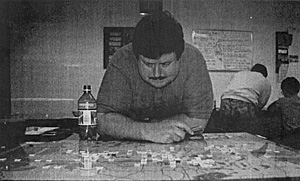 The Loneliness of Command: Bob Stettler leading the IDF in Yom Kippur.
The Loneliness of Command: Bob Stettler leading the IDF in Yom Kippur.
Zack and Marty played Hunters from the Sky. And Lee broke out Objective: Schmidt, with the Germans winning the "Counterattack at Kommerscheidt" scenario.
In all these cases, I believe, the players were using the TCS 3.1 rules. Over the last year this system has enjoyed its renaissance with the radically new 3.0 rules, and many of you are probably thinking of the TCS as finished and perfected. I was quite happy with the artillery system, and I balked when I first heard Dean talking about new artillery rules that would eliminate EFSs, rates of fire, and even plotting. Nor was I sure about the replacement of company morale with battalion morale. Version 3.1 contains these changes plus a number of smaller adjustments, including a new way to handle SFA sequencing. After seeing the new, more sensitive morale table, I became a believer in battalion morale tracking; Perry's not crazy about some "weird" morale effects. Perry is emphatic that the new artillery rules are "much better." Lee seemed enthusiastic about TCS after his game of GD'40 , and in summarizing it he stressed the way some good ideas on Op Sheets played out. The conclusion I draw is that the core of the system, the command rules, arejust as good as you remember, while the rest of the rules are even better. You can make up your own mind when you play Hunters.
One common theme among all the games I played or overheard was good sportsmanship. Players made gracious responses to "Oops, I forgot to move those guys," and bickering was nonexistent. There were intense moments on the maps, to be sure, but I didn't notice any sour reactions among the players. The focus was on fun.
Decorated Heroes
OK, there were no awards as such, but there were door prizes. On Sunday Dean interrupted the action long enough to hold a quick random drawing. Bill Quoss and Perry Andrus each won a year's subscription to Operations (lucky dogs!), and grand prize winner Lee Forester went home with a year of Ops plus a copy of No Better Place to Die. (Actually, he was already on his way back to Grand Rapids by then. Lee, did your game catch up with you yet?)
Some guys won informal honors as well. For example, I think the nods for most different games played go to Marty Arnsdorf and Zack Waltz, who were seen pushing cardboard with Hunters from the Sky, Afrika, and GMT's Battles of Waterloo (and maybe some others) and Chip Pharr, with Yom Kippur , No Better Place to Die, and Ardennes.
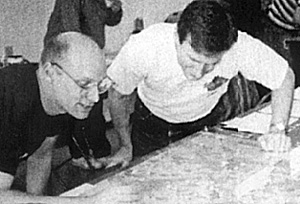 Boyd Schorman (left) explaining his "conservative " style ofplay to Keith Fortner.
Boyd Schorman (left) explaining his "conservative " style ofplay to Keith Fortner.
The single-game marathon champs were Dean, Dave Powell, Rod Miller, and Boyd Schorzman, who stuck with their Tunisia playtest throughout the retreat, with participation also by Keith Fortner, Owen Fuller, and me. I guess that makes Tunisia the most widely played game at the retreat, followed by Bloody Roads South and Ardennes .
I claim the stupidest move award, for capturing a hedgehog from Boyd's panzer boys in Tunisia and then failing to occupy it strongly enough. I held some units back to "garrison my line" without considering that a line surrounded by mountain hexes is invulnerable in the short term. The shortest game/knockout blow prize goes to Bill Quoss who, teaming with Chip Pharr, blew a big hole in the Americans and was cruising to a Massive Victory on turn 3 of Ardennes .
Burrito as Big as Your Head
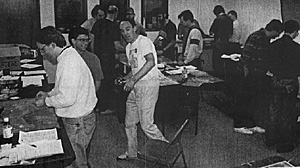 Perry Andrus (look of sheer terror, center) discovers for the first time what veterans call the "Revenge of the Burrito."
Perry Andrus (look of sheer terror, center) discovers for the first time what veterans call the "Revenge of the Burrito."
The greatest, or at least the strangest, honor of the weekend has less to do with gaming skill than with sheer guts. On Sunday afternoon we all headed for La Bamba in Champaign to confront that rite of passage, the Burrito as Big as Your Head. Everyone was up to the challenge, but somebody decided to up the ante. The dialog went something like this as Perry finished the last (and to my mind, most difficult) bite of his burrito.
Perry: "Man, I could eat a regular one of those now."
Several voices: "Yeah, right." "Suicide!" "Not sitting next to me you're not."
Dean: "It may be time to put your stomach where your mouth is."
Dean and his carload left shortly afterward, but many of us were there to witness Perry order-and consume-an additional regular burrito, a burrito you'd call large unless you saw it next to one of those 3-pound La Bamba specials. So here's to Perry Andrus, Burritofuhrer.
Gamers Labs Report
One aim of the Gamers Retreat is to kick back and have fun just playing wargames, as opposed to designing, testing, and tinkering with the things. But playtesting went on, as it will whenever Dean gets some talent together at the same gaming table. Those playing CWB games tried out a new 11..66 fire table with integrated straggler results. This table will show up in future NBS releases and is applicable to the CWB for those who like it. As I mentioned above, the TCS 3.1 rules got much attention and were generally well received.
What interested me, as a participant in both, was the contrast between this year's Tunisia testing and the EatG playtests at the '93 retreat. Last year some basic questions were up in the air, including revisions to the Barrage Table, supply costs for combat, the Soviet counter mix, and the overall feel and balance of the game. Dave Friedrichs kept shooting holes in theories with "They were never able to do that historically" or "That's completely invalid." The published Enemy, and the OCS 2.0 rules, are substantially different from the game we tested a year ago, and making those beneficial changes entailed more than a little stress. This time around, Dean characterized the necessary changes to Tunisia as "tweaks." Maybe the American troops will be a bit less klutzy in the final version. And the map will reflect Rod's suggestions for better readability. The mood around the table was more relaxed, as everyone felt the game design and, especially, the underlying system were in good working order.
One question arose about the OCS air system. With the new air rules, especially the Put Up or Shut Up rule, a player may push to dominate the airspace over part of the map. Major air battles can develop, and one side might see its air force heading down the slippery slope to destruction. On Sunday night we gathered in The Gainers' library to discuss whether the air rules needed revision. Rod pointed out, "Once you #*&@ up, you can never recover," and Boyd replied, with emphatic directness, "Then, don't #!*&@ up!"
The questions raised had to do with the realism of the present system, the intended feet of the air system, and whether we had found a loophole for gamey tricks. Even as we tried to decide whether a problem existed, exotic solutions came up, including air zones, replacements for rebuilding aircraft, modifications to the Air-to-Air Combat Table, and even an abstract point-based system. In the end we decided the perceived problem was trivial (if existent at all) and the OCS rules remain set. Players are, of course, advised to follow Boyd's Rule.
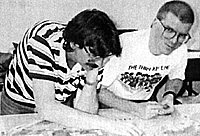 Marty Arnsdorf and Zack Waltz show what the hobby is all about--having a good time playing games.
Marty Arnsdorf and Zack Waltz show what the hobby is all about--having a good time playing games.
The new ideas that saw light and the exhaustive discussion of the OCS air game demonstrate that Dean is always on the lookout to fix problems or make improvements. But any suggested change has to be important enough to justify shaking up an established series rulebook. It's fun to see the thinking that goes into these games.
For that matter, it's fun to watch Dean edit a game map on his Macintosh. It's fun to trade stories about glorious or dismal dice rolls. Most of all, it's fun to get away from the world and concentrate on some good face-to-face wargaming. I'm looking forward to next year.
Back to Table of Contents -- Operations #15
Back to Operations List of Issues
Back to MagWeb Master List of Magazines
© Copyright 1994 by The Gamers.
This article appears in MagWeb (Magazine Web) on the Internet World Wide Web.
Other military history articles and gaming articles are available at http://www.magweb.com